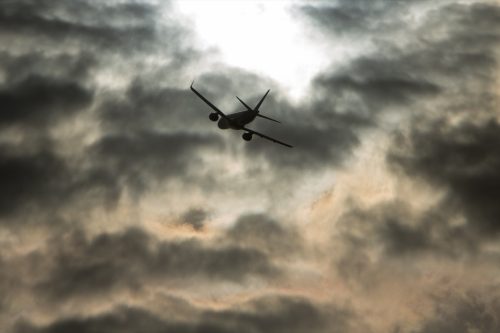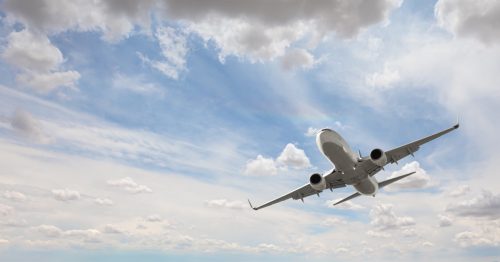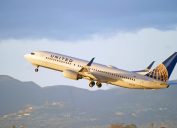Why Severe Turbulence Is Becoming More Common on Flights
Experts say the time of day you should book to avoid.

Few things are worse than a bumpy plane ride. If you're a nervous flyer, the situation is anxiety-inducing, and if you suffer from motion sickness, you might find yourself both nervous and nauseas. We've all experienced some in-flight bumps while traveling, and maybe even some that felt pretty intense. Currently, pilots report roughly 5,500 incidents of severe turbulence annually (which is actually a very small percentage of the total flights that hit the skies), but experts say that things could get a lot bumpier soon. Read on to find out why severe turbulence is becoming more common on flights, and what you can do to keep yourself safe.
READ THIS NEXT: Never Do This After Checking a Bag, Flight Attendant Says.
There are different kinds of turbulence.

Captain Laura Einsetler, commercial airline pilot and author of CaptainLaura.com, explains that there are a few different kinds of turbulence (and several subcategories). One is mechanical turbulence, "where the wind's flow is disrupted by things like mountains or building structures." Another is convection, which is associated with "air pressure causing vertical shearing." According to the Federal Aviation Administration (FAA), wind shear is when wind changes direction or speed over a short distance, either horizontally or vertically.
A third kind of turbulence is clear-air, which, as its name suggests, doesn't have a cause that's visible to the naked eye (think clouds or a thunderstorm). Pilots often don't know it's coming, so they can't warn passengers—and as luck would have it, this turbulence is the real troublemaker.
Turbulence is increasing because of climate change.

Paul Williams, a professor of atmospheric science at the University of Reading in the U.K., told CNN that clear-air turbulence will "increase significantly" across the globe by the years 2050 to 2080, with strongest turbulence seeing the biggest increase.
In a study that Williams co-authored published in 2019, researchers found that the reason for these changes is climate change.
"We have accumulated a large body of scientific evidence now that turbulence is increasing because of climate change," Williams told Newsweek. "An invisible form called clear-air turbulence is generated by wind shear, which, because of climate change, is now 15 percent stronger than in the 1970s. We expect a further strengthening of the wind shear in the coming decades, perhaps doubling or tripling the amount of severe turbulence."
Einsetler agrees that rising temperatures are having a great effect on the skies. "As the temperature of the earth rises, this gives way to pressure differentials in the atmosphere causing stronger winds, larger and faster moving weather systems, and more intense storms," she says. "The greater the pressure differences in areas, the greater the shear effects in the air."
As for what flights will be bumpier, Stephen Bennett, chairman of the American Meteorological Society's Committee on Financial Weather and Climate Risk, and co-founder and chief climate officer of The Demex Group, told Insider that these changes will largely affect transatlantic flights.
"The highest altitude flights over the North Atlantic will encounter the most significant increase in severe turbulence," Bennett told the outlet.
For more travel news delivered straight to your inbox, sign up for our daily newsletter.
Don't worry just yet.

We've seen a few reports of severe turbulence lately, most notably on a Lufthansa flight in which seven passengers where hospitalized, USA Today reported.
However, there's no need to panic. Bennett told Insider that he believes technology will be developed to better detect clear-air turbulence and routes will be adjusted to avoid areas where this kind of turbulence is more common.
"While it may seem like flying could become more dangerous because of climate change, it's just not that simple," Bennett said.
Isabel Smith, meteorologist and PhD student at the University of Reading, who also studies climate and turbulence, said the severe variety is still pretty rare, too.
"You may encounter more turbulence in the future," she told Insider. "But this is much more likely to be light turbulence, which won't cause any serious injuries."
Patrick Smith, airline pilot and author of Ask the Pilot, also said you might want to take reports about turbulence with a grain of salt. "More planes are flying than ever before, so even if the total number of incidents is going up, percentage-wise it may or may not be changing," Smith told Best Life.
Pilots do their best to avoid turbulence, but there are steps you can take too.

Einsetler also said that, in general, pilots are committed to avoiding turbulence. "Traveler's should know that we do our best to avoid these areas of turbulence by taking alternate routes or different altitudes to give them the smoothest rides we can," she said.
To keep yourself safe, however, the FAA recommends keeping your seat belt buckled at all times. If you're really concerned about encountering turbulence, Einsetler also suggested booking your flights strategically.
"The best time to fly is early morning," she said. "[Try to] fly on the largest aircraft possible—large airport to large airport if your route permits—and take the safest and most well-established airlines."





















